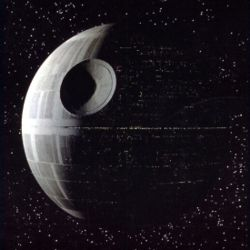Building a Death Star, the fictional space station from the Star Wars universe, would require a tremendous amount of resources, technology, and infrastructure. While it is impossible to provide an accurate estimate of the exact amount of resources needed to build a Death Star, we can make some educated guesses based on the information available in the Star Wars movies and expanded universe.
In the Star Wars movies, the Death Star is described as being approximately 120 kilometers in diameter. It is also shown to have a complex network of internal structures, such as hangars, barracks, and power generators. It is equipped with a planet-destroying superlaser and a complement of TIE fighters and other spacecraft.
Based on these factors, it is likely that building a Death Star would require an enormous amount of resources, including:
Raw materials:
The construction of a structure as large as the Death Star would require an enormous amount of raw materials, including metals, plastics, and other materials. It is possible that the materials could be mined from nearby planets or asteroids, but transporting them to the construction site would require a massive fleet of transport vessels.
Energy:
The Death Star would require a tremendous amount of energy to power its superlaser, life support systems, and other internal systems. It is possible that this energy could be generated using advanced technology, such as fusion reactors, but this would still require a significant investment in infrastructure.
Labor:
Building a structure as complex as the Death Star would require a massive workforce, including engineers, scientists, and construction workers. The scale of the project would make it one of the largest engineering and construction efforts in history.
Technology:
The Death Star would require a range of advanced technologies, including faster-than-light travel, gravity control, and superlaser technology. Developing and implementing these technologies would require a significant investment in research and development.
How much food and water would it need for its staff?
The exact number of staff members, as well as their food and water requirements, are not specified in the movies or expanded universe. However, we can make some educated guesses based on what we know about space station design and human needs.
Assuming the Death Star has a large crew, likely in the tens or hundreds of thousands, it would require a significant amount of food and water to sustain them. The amount of food and water needed would depend on a number of factors, such as the length of the crew’s stay, their daily caloric and hydration needs, and the availability of food and water recycling technology.
According to NASA, the typical daily water requirement for an astronaut is around 3.8 liters (1 gallon), which includes drinking, cooking, and hygiene needs. However, this requirement can vary based on factors such as climate, activity level, and individual needs. Assuming a crew of 100,000 and a daily water requirement of 3.8 liters per person, the Death Star would need to supply at least 380,000 liters of water per day.
Food requirements are more difficult to estimate, as they depend on a variety of factors such as the age, gender, and activity level of the crew members, as well as the availability of food storage and recycling technology. A good estimate for daily caloric intake is around 2,500 calories per person, although this can vary widely depending on the individual. Assuming a crew of 100,000 and a daily caloric intake of 2,500 calories per person, the Death Star would need to supply at least 250 million calories per day.
It’s worth noting that the actual food and water requirements for a space station as large and complex as the Death Star would likely be much higher than these estimates, given the scale of the project and the advanced technology and infrastructure needed to sustain human life in space. Additionally, the Death Star may have had advanced food and water recycling technology to minimize the need for resupply, further complicating any estimate.
What retail units would it have?
The Death Star was primarily designed as a military installation and was not intended to serve as a commercial or retail hub. Therefore, there is no official information about what retail units or commercial facilities it would have.
However, in the Star Wars movies and expanded universe, we do see some examples of retail units and commercial facilities on other space stations and planets. For example, the spaceport on the planet of Tatooine, which is featured in the original Star Wars movie, has a variety of retail units selling goods such as droids, weapons, and food.
If the Death Star were to have any retail units, they might include facilities such as:
Supply and maintenance shops:
The Death Star would require a wide range of supplies and spare parts to maintain its complex infrastructure and technology. Therefore, it’s possible that the station might have shops or supply depots to procure and store such supplies.
Cafeterias and dining facilities:
Given the large crew and staff that the Death Star would require, it is likely that the station would have dining facilities to feed them. These could include cafeterias, restaurants, or other food vendors.
Recreational facilities:
Even military installations need to provide opportunities for their personnel to relax and unwind. The Death Star might have recreational facilities, such as gyms, game rooms, or movie theaters.
Gift shops:
It’s possible that the Death Star might have gift shops or souvenir vendors, selling memorabilia related to the station or the Empire.
However, it’s important to note that the Death Star was primarily designed as a military installation, and any commercial or retail facilities it might have would likely be secondary to its primary purpose.
If a Death Star was created today you could expect to find at least 1000 Costa’s as they appear to be everywhere anyway, along with McDonalds and Burger King. In fact, try to imagine a large airport like Heathrow and multiply the services available by 1000.
Given the enormity of the project, it is likely that building a Death Star would cost trillions or even quadrillions of credits, assuming the technology to build such a structure was even possible in the first place. It’s important to note, however, that the Death Star is a fictional construct, and the resources required to build it are beyond the current capabilities of human technology.

